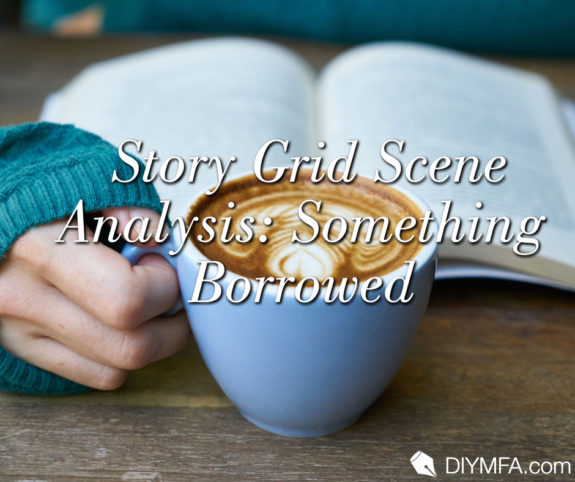If you’ve been following my last two articles on scene analysis, you know how valuable I believe it is for writers to understand how to determine if a scene either advances the plot and/or develops the character(s). This is especially important if it is the opening chapter of a novel. Before I became a Certified Story Grid Editor, I studied tons of writing craft resources in hopes of mastering this storytelling-must, and I accrued a tremendous batch of implicit-turned-explicit knowledge in the process.
However, to this day, nothing has elevated my ability to identify what makes a scene “work” like the Story Grid Scene Analysis Template. In fact, I believe in these scene-analyzing tools and principles so much that I’m dedicating my monthly columns to teaching you how to master scene analysis, too.
Why?
Because this will help you learn how to read like a writer, which means mastering how to Read With a Purpose! Score!
As a quick reminder, some of the essentials I will use in today’s scene analysis—as I breakdown the opening scene in Emily Griffin’s bestseller Something Borrowed—can be found in my initial article about Story Grid’s Scene Analysis Template, which I highly recommend you take a few minutes to review if you find you are unfamiliar with any of the following terms/tools/principles in the remainder of this article.
All set?
Great! Let’s dive into how Emily Griffin enlivens a scene that works in the opening of her breakout novel, Something Borrowed.
Something Borrowed: Chapter One Summary
Something Borrowed by Emily Griffin is a New York Times bestseller and women’s fiction masterwork that depicts what Entertainment Weekly called, “the hopeful hearts behind and unsympathetic situation.” Published by St. Martin’s in 2005, Griffin’s novel brought a new voice to women’s fiction with a tale about two friends and their relationship that goes comically awry after the so-called “good girl” and protagonist, Rachel, sleeps with Dex, the fiancé of her best friend, Darcy.
Before this scandalous night, hard-working lawyer and likeable Rachel always felt second-best to Darcy’s charm and good luck (and looks). She dutifully accepted the role of sidekick, happy to support Darcy’s dreams and endeavors even if Darcy never treated Rachel with equal respect. And yet, several of the crooks fabricating this lopsided relationship explode in Chapter One of Something Borrowed, set on the eve of Rachel’s thirtieth birthday.
Here’s the rundown:
In this chapter—or scene—we learn an important backstory about Rachel and Darcy’s relationship, which clearly establishes Rachel’s view of Darcy as the better-half in their dynamic duo. Rachel is vulnerable and flawed, and we momentarily sympathize for her. This is Rachel’s lot in life, which she’s been fine with at some low level. But now she is starting to recognize a whole new level of insecurity and longing amidst her reflection on her friendship with Darcy.
Rachel shares the childhood memory of how Darcy and she discussed their assumptions for what they would do on their thirtieth birthdays. Rachel predicted it would include some form of celebration with her charming husband with her as a happily married and successful mother and lawyer.
When the day comes, in reality she’s faced with unavoidable emptiness. Griffin writes, “My wants are simple: a job that I like and a guy whom I love. And on the eve of my thirtieth, I must face that I am 0 for 2.”
On the flip side, still-best-friend Darcy loves her job and is newly engaged to Dex (who Rachel introduced to Darcy). Rachel—trying to have fun on her birthday night out with friends—can’t stop ruminating about how Darcy is the “lucky one.” They’re in a much better place than Rachel because when you’re “engaged or married, turning thirty just isn’t the same thing.”
Cue the sad violin.
Despite the self-pity, Rachel keeps all these opinions to herself. In this light, the reader understands Rachel’s defeatist thoughts because what middle aged person hasn’t questioned their professional and romantic position in life at one point or another? Don’t say you haven’t. This is human, and this is what draws the reader closer to Rachel.
While Darcy flirts with a bartender in the fancy New York City restaurant, Rachel concludes a hard truth. She’s unsettled about her future and slightly regretful about her past. She has good things going for her, sure, but overall she’s just…meh.
As the birthday night progresses, Rachel grows increasingly more drunk. There’s dancing and Darcy is the center of attention. Later, Dex starts to escort his drunk fiance home but he is nagged into staying. This poses a complication that, unbeknownst to Rachel, will raise Rachel’s internal and external stakes.
Rachel and Dex head for another drink in a different bar. Here, they really start to bond and we sense their instinctive chemistry. Complications arise when Rachel nearly mentions a memory of Darcy. But reminding Dex of Darcy would spur him home to her, and Rachel isn’t ready for that yet. With this, the reader is sucked deeper into the sticky-potential of the story. Something is going on and the tension continues to crank up the heat.
On their way home, Dex tells the cab driver to make it two stops. The night seems to be on its last end until—Dex starts kissing Rachel without warning. Between kisses, stakes boil over when Rachel hears Dex tell the cab driver it will only be one stop.
At her apartment, Rachel admits that she experiences a “lucid instant where I consider what I was missing in my twenties” and what she wishes to find in her thirties. With this redirected focus, Rachel pushes Darcy out of her mind and embraces Dex in her bed.
Thus begins the wild emotional roller coaster that will unravel not only Rachel’s internal search for satisfaction while potentially ruining her oldest friendship, but the romantic events that dangerously complicate the page-turning plot of Griffin’s New York Times bestseller.
Analyzing the Scene
Remember!
A STORY EVENT is an active change of life value for one or more characters as a result of conflict (one character’s desires clash with another’s).
A WORKING SCENE contains at least one Story Event.
To determine a Scene’s Story Event, answer these four questions.
- What are the characters literally doing? Rachel celebrates her thirtieth birthday with her friends, including Darcy and Dex.
- What is the essential action (character’s want/intention) of what the characters are doing in the scene? On a global scale, Rachel shares that she wants a job that she’s happy with and a man that she loves. She also shares that, in this scene, she has neither. If only, if only! The essential action that illustrates Rachel’s movement towards getting one of these is when Darcy goes home, and eventually Rachel and Dex stay behind—alone—for another drink.
- What life value has changed for one or more of the characters in the scene? Rachel starts this scene unsettled and slightly depressed—she’s not happy with her current romantic and professional life as she enters middle-age. During her birthday celebration, she continually compares her disappointing circumstances to Darcy’s marvelous ones. Although unintentional in how her actions could hurt Darcy, Rachel’s position starts to shift after Darcy leaves and Rachel spends time alone with Dex—eventually leading to a wild, scandalous hookup. On a grand scale, Dex moves from Committed to Infidelity.
- Which life value should I highlight on my Story Grid Spreadsheet? Rachel moves from Unsettled to Romantically Charged/Excited—this could also be viewed as an agent of Loyalty to Betrayal. (Remember, we use the Socratic Learning Method when analyzing scenes, so how I name/see a value shift could be different than you! It’s not about naming the shift with the perfect words that make you a strong reader, but rather identifying how a shift exists while also understanding how to argue why this advances the plot and develops the character(s).)
How the Scene Abides the Five Commandments of Storytelling
Inciting Incident: Causal. Darcy invites Rachel to a birthday dinner (this is an inciting incident that occurs in medias res; it initiates Rachel’s night out with her friends).
(Progressive Complication) Turning Point: Action. Dex invites Rachel for another drink after everybody leaves.
Crisis: Best Bad Choice. Rachel can deny Dex’s invitation, guaranteeing that she will return home thirty and alone, or, Rachel can accept Dex’s invitation even if Dex isn’t Rachel’s boyfriend and doing so could lead to more intimate bonding.
Climax: Rachel accepts Dex’s invitation. At the next bar, they bond over commonalities and eventually take a cab home. Although Dex instructs the cab driver to make two stops, the ride quickly escalates into a backseat make-out session. Rachel and Dex both get out at Rachel’s apartment and go upstairs together.
Resolution: Rachel and Dex hookup.
The Big Takeaway
Looking at this scene, it’s somewhat obvious as to why this opening chapter immediately captivates the reader. There are high stakes on both a romantic and internal scale.
Although some lines are blurred as to who initiates the hookup—Dex or Rachel—ultimately, they’re both responsible for the events that unfold. In any story, a hookup flush with romantic chemistry is enough to tug the reader forward (here we come chapter two!) because it stimulates a value shift.
What makes Something Borrowed’s opening chapter even more encapsulating is Rachel’s internal stakes mixed with her external ones. We see an explosion of private stakes turned public because of how the events will inevitably impact more than Rachel’s internal and romantic state after this night.
In this light, it’s remarkably clear that both the plot has advanced and Rachel’s character has developed. There’s a lot more than meets the eye in this New York, middle-aged woman looking for a more satisfying professional and romantic life in this book. As readers, we’re eager to find out what Rachel’s willing to sacrifice and risk in order to get what she wants.
This opening chapter presents a scene that works in a big way, and understanding why it works using Story Grid’s Scene Analysis Template will only help you level up your skills as a reader and writer—by teaching you how to read with a purpose.

Abigail K. Perry is a Certified Story Grid Editor with professional teaching, literary agency, and film production experience. In addition to writing masterwork guides that help people learn how to write, read, and edit like a writer, she works as a freelance developmental editor/book coach and diagnostic editor, and is a monthly columnist for DIY MFA. Abigail also teaches Genre-Focused writing workshops for the genres she specializes in, which include Women’s Fiction, YA Fantasy, Upmarket Fiction, Historical Fiction, and Scripts. As a podcaster, she’s a passionate advocate for the butterfly effect stories have on the individual and world, which she shares with listeners on her podcast, STORY EFFECT. Visit Abigail’s website if you’re a writer looking for an editor who will help you grow as storyteller, and who has experience in differentiated instruction, traditional publishing, and film.







